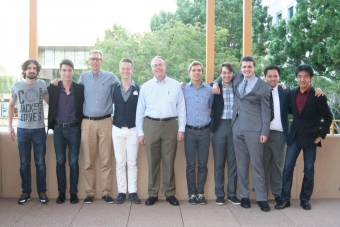St. Margaret’s High School Summer Internship Program Celebrates 10 Years at Samueli School
 Sept. 2014 - Seven high school students participated in this year’s St. Margaret’s Episcopal School Summer Internship Program at the Samueli School of Engineering. They presented their research projects to their parents, teachers and the engineering faculty and graduate students who mentored them at a recent event in the Harut Barsamian Colloquia Room, hosted by Samueli School Dean Gregory Washington.
Sept. 2014 - Seven high school students participated in this year’s St. Margaret’s Episcopal School Summer Internship Program at the Samueli School of Engineering. They presented their research projects to their parents, teachers and the engineering faculty and graduate students who mentored them at a recent event in the Harut Barsamian Colloquia Room, hosted by Samueli School Dean Gregory Washington.
Now in its 10th year, the internship program matches high-potential students with a faculty member and research area based on their interests. Spearheaded by Engineering Leadership Council member Stacey Nicholas, the program aims to inspire enthusiasm for STEM fields with the hope that the high school students will pursue these areas as they move forward in their education and careers. Washington reports that 85 percent of the U.S. economy is tied to advances in STEM, but only 4 percent of our workforce is in these areas.
“Being in the lab, side-by-side with professional engineers really gave us insight into what ‘conducting research’ actually means,” says St. Margaret’s student Ben Wang.
“I never knew how much thought and how many intricate details go into even the seemingly, simple experiments,” adds St. Margaret’s student Greg Justice. “This program really opened my eyes to it.”
The program accepts five to 10 students each summer, and over the years admission has become increasingly competitive as it is based on students’ GPA and academic merits. Along with university-level engineering research experience, the students also receive university credit to add to their college applications.
“It’s really an incredible experience for our students,” says Jennifer Ross-Viola, St. Margaret’s School science department chairperson. “They gain insight to what collegiate-level engineering research entails and the confidence to actively seek out labs to work in when they get to college. In fact, one of our students, who participated in the program two years ago, still continues to do research in the same laboratory today.
“We’d like to extend our deep gratitude to Stacey Nicholas, Dean Washington and the Samueli School of Engineering for continuing in this relationship and for allowing our students to participate in this program.”
Here are this year’s student projects:
Under the guidance of civil and environmental engineering professor Stephen Ritchie, Zack Venable contributed on a project to alleviate vehicle congestion and reduce emission at Joshua tree National Park by introducing a voluntary transit system.
David Weaver worked with mechanical and aerospace engineering professor David Reinkensmeyer on a device that uses sound as a positive feedback mechanism to help stroke patients relearn movements.
Lance Lew’s project, “SCALE Dashboard Creation,” uses the Internet of Things, a network of connected technologies that can send and receive data, to promote public safety. Lew worked with computer science professor Nalini Venkatasubramanian.
Ben Wang collaborated with Young Jik Kwon, associate professor of pharmaceutical sciences, on his project, “BioTel.” Wang used assays to examine the cytotoxicity of “Human Natural Killer cells” on certain cell lines.
Greg Justice researched the maximum water content of a methane flame to learn about a potential alternate energy source. He conducted his project with mechanical and aerospace engineering professor Derek Dunn-Rankin.
Christian Carnahan’s project involved using an atomic force microscope to examine the surface of graphene for contaminants. He was paired with electrical engineering and computer science professor Peter J. Burke.
Liam McGregor worked with Reinkensmeyer to develop and test engaging therapy methods for stroke patients. McGregor’s project created two new modes for a music glove designed for exercising tactile skills. One of the new mode’s features allow patients to use the music glove to create their own musical pattern.
